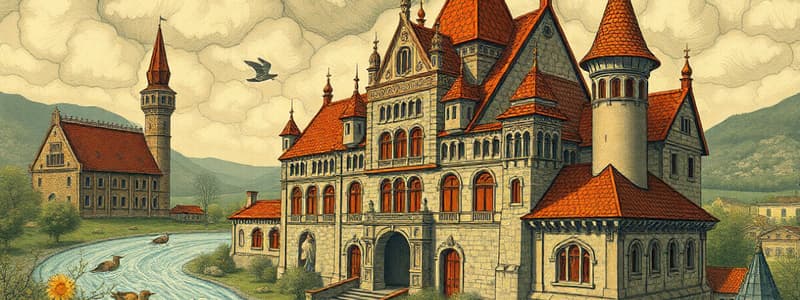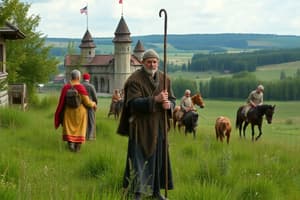Podcast
Questions and Answers
The Kievan Rus was primarily known for its lack of trade relationships with European powers.
The Kievan Rus was primarily known for its lack of trade relationships with European powers.
False (B)
The decline of Constantinople had a positive impact on the trade of the Kievan Rus.
The decline of Constantinople had a positive impact on the trade of the Kievan Rus.
False (B)
Moscow emerged as a significant power after the decline of Kievan Rus by challenging the Mongol Khans.
Moscow emerged as a significant power after the decline of Kievan Rus by challenging the Mongol Khans.
True (A)
The Kievan Rus was completely unified and did not experience any internal disputes over succession.
The Kievan Rus was completely unified and did not experience any internal disputes over succession.
The influence of Poland and Lithuania was limited to the eastern regions of the former Kievan Rus.
The influence of Poland and Lithuania was limited to the eastern regions of the former Kievan Rus.
The tribes that spread through Eastern Europe in the first millennium had a writing system.
The tribes that spread through Eastern Europe in the first millennium had a writing system.
Nestor compiled the Primary Chronicle in the 12th century.
Nestor compiled the Primary Chronicle in the 12th century.
The Vikings who invaded the tribes of Eastern Europe wore horned helmets in battle.
The Vikings who invaded the tribes of Eastern Europe wore horned helmets in battle.
Oleg moved the capital of Kievan Rus to Novgorod.
Oleg moved the capital of Kievan Rus to Novgorod.
Vladimir I rejected Islam because of its prohibition on alcohol.
Vladimir I rejected Islam because of its prohibition on alcohol.
The relationship between Kievan Rus and the Byzantine Empire was heavily influenced by trade along the Dnieper River.
The relationship between Kievan Rus and the Byzantine Empire was heavily influenced by trade along the Dnieper River.
The alphabet for Slavic languages was created by Byzantine missionaries.
The alphabet for Slavic languages was created by Byzantine missionaries.
The Kievan Rus had peaceful relations with the Khazar Empire throughout its history.
The Kievan Rus had peaceful relations with the Khazar Empire throughout its history.
The tribes in Eastern Europe during the first millennium had a common Slavic language and polytheistic religion.
The tribes in Eastern Europe during the first millennium had a common Slavic language and polytheistic religion.
Rurik was the first ruler of Kievan Rus who expanded the realm into the south.
Rurik was the first ruler of Kievan Rus who expanded the realm into the south.
The Kievan Rus existed in a constant state of peace with its neighboring tribes.
The Kievan Rus existed in a constant state of peace with its neighboring tribes.
Vladimir I chose Orthodox Christianity because he found the ceremonies to be strange.
Vladimir I chose Orthodox Christianity because he found the ceremonies to be strange.
Members of the Kievan Rus aristocracy maintained a close relationship with the Khazar Empire throughout their existence.
Members of the Kievan Rus aristocracy maintained a close relationship with the Khazar Empire throughout their existence.
The tribes in Eastern Europe reached out to the Vikings after expelling them due to chaos among themselves.
The tribes in Eastern Europe reached out to the Vikings after expelling them due to chaos among themselves.
Nestor's Primary Chronicle was completed in the 10th century.
Nestor's Primary Chronicle was completed in the 10th century.
Byzantine missionaries created an alphabet for Slavic languages that was based on the Latin script.
Byzantine missionaries created an alphabet for Slavic languages that was based on the Latin script.
Fratricidal disputes over succession in Kievan Rus did not affect its central power.
Fratricidal disputes over succession in Kievan Rus did not affect its central power.
The Mongol invasion led by Batu Khan significantly impacted the cities of Kievan Rus.
The Mongol invasion led by Batu Khan significantly impacted the cities of Kievan Rus.
Moscow developed as a significant power in the west by opposing the influences of Poland and Lithuania.
Moscow developed as a significant power in the west by opposing the influences of Poland and Lithuania.
The Teutonic crusaders posed a threat to the northern territories of Kievan Rus.
The Teutonic crusaders posed a threat to the northern territories of Kievan Rus.
Kievan Rus enjoyed a high degree of culture and literacy, with democratic freedoms for its time.
Kievan Rus enjoyed a high degree of culture and literacy, with democratic freedoms for its time.
Flashcards
Kievan Rus' decline
Kievan Rus' decline
The fall of Kievan Rus' was caused by internal conflicts, external threats, and the Mongol invasion.
Mongol invasion
Mongol invasion
A devastating invasion of Rus' cities by the Mongols, led by Batu Khan, marking a turning point.
Moscow's rise
Moscow's rise
From a small trading post, Moscow rose to challenge and ultimately replace the Mongol Empire's influence in Eastern Rus'.
Rus' division
Rus' division
Signup and view all the flashcards
Influence of the Mongols
Influence of the Mongols
Signup and view all the flashcards
Kievan Rus' origin
Kievan Rus' origin
Signup and view all the flashcards
Kievan Rus' size
Kievan Rus' size
Signup and view all the flashcards
Reasons for conversion to Christianity
Reasons for conversion to Christianity
Signup and view all the flashcards
Primary Chronicle
Primary Chronicle
Signup and view all the flashcards
Slavic tribes
Slavic tribes
Signup and view all the flashcards
Rurik
Rurik
Signup and view all the flashcards
Viking influence
Viking influence
Signup and view all the flashcards
Byzantine relations
Byzantine relations
Signup and view all the flashcards
Kievan Rus' Expansion
Kievan Rus' Expansion
Signup and view all the flashcards
Kievan Rus' religion
Kievan Rus' religion
Signup and view all the flashcards
Kievan Rus' Neighbors
Kievan Rus' Neighbors
Signup and view all the flashcards
Byzantine influence on Kievan Rus'
Byzantine influence on Kievan Rus'
Signup and view all the flashcards
Kievan Rus' wealth
Kievan Rus' wealth
Signup and view all the flashcards
Mongol impact on Rus'
Mongol impact on Rus'
Signup and view all the flashcards
Moscow's rise to dominance
Moscow's rise to dominance
Signup and view all the flashcards
Legacy of Kievan Rus'
Legacy of Kievan Rus'
Signup and view all the flashcards
Study Notes
Origins of Russia
- Early Eastern European tribes, speaking a Slavic language and practicing polytheism, spread through the woodlands.
- Knowledge of these tribes comes from archaeological findings, accounts of Roman & Middle Eastern scholars, and the 12th-century Primary Chronicle.
- By the 7th century, these tribes had split into western, southern, and eastern branches; the last stretched from the Dniester River to the Volga and Baltic Sea.
Kievan Rus' Formation
- Viking raids and subjugation in the region eventually led to revolt and expulsion
- Tribes invited Vikings, including Prince Rurik and his brothers, back to establish order, leading to establishment of Kievan Rus'.
- Rurik's son Oleg expanded the realm, moving the capital to Kiev, a previous Khazar outpost.
- Kievan Rus' grew through alliances and conflicts with surrounding powers like the Khazars and Byzantines.
Kievan Rus' Golden Age and Decline
- The conversion of Prince Vladimir I to Orthodox Christianity in 987 strengthened ties with the Byzantine Empire.
- This conversion also facilitated significant cultural and religious exchanges.
- The adoption of the Cyrillic alphabet from the Byzantine script contributed to the development of Slavic languages.
- Prosperity and significant cultural developments occurred, such as trade along the Volga River and prominent marriages to European monarchs.
- Internal conflicts over succession, external pressures of the Fourth Crusade damaging trade, and attacks from the Teutonic Order gradually weakened the state.
Mongol Conquest and Fragmentation
- The Mongol invasion, led by Batu Khan in 1237, marked the end of Kievan Rus'.
- After Kiev was sacked, the Mongols continued their advance into Hungary and Poland.
- Eastern Rus' regions fell under Mongol control while western regions maintained their independence until the departure of the Mongols.
- Moscow, a small trading post, emerged as a power, eventually conquering vast territories and reclaiming the name Russia.
- The political fragmentation of the former Kievan Rus' territories led to distinct cultural and linguistic differences between East and West Russia.
Differences Between Russia and its Neighbors (implied):
- Eastern Rus' territories, largely impacted by Mongol rule, developed under Moscow's dominance, eventually taking on the name "Russia".
- Western Rus' territories, escaping the Mongol destruction, fell under the control of Poland and Lithuania, diverging culturally and linguistically.
Studying That Suits You
Use AI to generate personalized quizzes and flashcards to suit your learning preferences.
Description
Explore the fascinating history of Kievan Rus', from its early Eastern European tribes to its formation under Viking leadership. This quiz covers the significant events, cultural shifts, and political dynamics that shaped the rise and decline of one of Eastern Europe's historical empires. Test your knowledge on this pivotal period in history.




